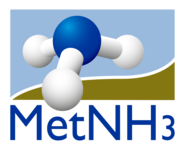Publications & Results
The main results and publications of the 5 Work Packages (WPs) of JRP MetNH3 are presented in this section.
WP1: Realisation of ammonia reference gas mixture standards
Progress until December 2016
The main objective of WP1 is the development of improved gas mixture standards by static gravimetric and dynamic methods. The highly adsorbing/desorbing behaviour of ammonia molecules and the purity of the matrix gas challenge the preparation of ammonia primary reference standards.
NPL and VSL have tested different cylinder types by performing a series of decant tests at the 100 and 10 µmol/mol levels. These tests showed minimised adsorption of ammonia molecules on internal surfaces of stainless steel cylindes passivated using the SilcoNert2000® treatment by SilcoTek Inc.. For such coated cylinders, no significant difference in amount fraction between the parent and daughter mixtures in each decant experiment could be observed. In addition the effect of pressure changes on the adsorption/desorption of molecules was investigated. Reactive molecules adsorbed on cylinder surfaces tend to desorb as the pressure in the cylinder decreases. No such effect could be observed in the SilcoNert2000® treated stainless steel cylinders. The long term stability of the mixtures prepared in these cylinders has been monitored throughout the project.
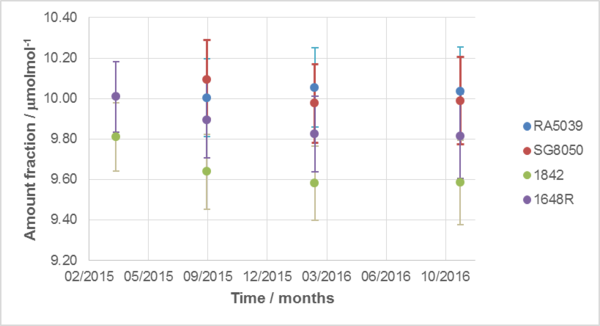 |
In order to reduce the uncertainty in the final ammonia amount fraction of the primary standards, NPL and VSL have undertaken extensive purity analyses of the balance nitrogen gas used to preparethese mixtures. Impurities can affect the ammonia amount fraction either by directly reacting with ammonia, or by interfering with its measurement. The measurements involved very challenging quantifications of trace impurities of a number of components (ammonia, water, formaldehyde, carbon dioxide and methane) at the low nmol/mol level. The level of impurities found in the matrix gas had no effect on the amount fraction uncertainty of ammonia standards in cylinder nor will they affect the analysis of ammonia standards. It has to be mentioned that only high quality matrix gases were used in the preparation. In addition special care should be taken during preparation to avoid introduction of any water from tubing or valves.
NPL has developed a facility for the dynamic dilution of ammonia primary reference standards using high-accuracy mass flow controllers. This facility provides a direct method of comparison and validation of the cylinder mixtures prepared by NPL and VSL with the permeation systems developed by BAM and METAS.
Partners METAS and BAM have constructed two mobile NH3 reference gas generators at their respective institutes. They are used to dynamically generate SI-traceable NH3 reference gas mixtures of 0.5-500 nmol/mol with an expanded uncertainty UNH3<3% (k = 2) for the on-site calibration of optical instruments. All surfaces in contact with NH3 are coated with SilcoNert2000®. METAS’ reference gas generator ReGaS1 has been characterised, validated and successfully used for two laboratory intercomparisons and the field intercomparison at CEH in Scotland.
Following the procedure of Vaittinen et al. (“Adsorption of ammonia on treated stainless steel and polymer surfaces” Appl. Phys. B 115, pp.185–196, doi: 10.1007/s00340-013-5590-3, 2013), partners VSL and METAS have studied the adsorption of NH3 on different surfaces, such as stainless steel and varieties of Teflon. In addition, SilcoNert2000® coated stainless steel has been tested by exposing a surface of known dimensions to NH3 at nmol/mol amount fractions. The test results confirm those of Vaittinen et al. in that the least NH3 molecules were adsorbed on Teflon surfaces. However, Silconert2000® treated stainless steel surfaces showed similarly small adsorption. The difference to untreated electro-polished stainless steel surfaces, however, is substantial with 10 times more molecules adsorbed by the untreated surface.
Partners REG UH and METAS have continued the adsorption experiments at different levels of humidity in the matrix gas in order to assess the influence of water on the adsorption of NH3. The ammonia adsorption was found to increase substantially in dry conditions. The increase was largest for plain stainless steel which was the most adsorbing material. The coatings applied on stainless steel decreased the adsorption significantly in dry conditions. Polymers PVDF and PTFE were the least adsorbing materials. For water amount fractions between 1000 and 10000 µmol/mol, the smallest ammonia adsorption was found. The adsorption increased again above 10000 µmol/mol (one percent) humidity levels. This is, presumably, due to the dissolution of ammonia on the multiple water layers present on the material surface.
WP2: Development of standard optical methods
Progress until December 2016
WP2 has completed the experimental work towards standard optical measurement methods. After extensive efforts to characterise extractive cavity ring-down spectrometers (CRDS) by Picarro Inc. by partners PTB, NPL and METAS the focus in the last project period was on intercomparison measurements.
A number of points have been identified that are considered to be crucial to achieve traceability in ambient ammonia measurements in the 0.5-500 nmol/mol amount fraction range. Firstly, it has been noticed that the spectrometer calibration is valid only in air; the slope of a calibration line measured in nitrogen matrix gas is 10 % lower. Calibration gases are often prepared in nitrogen matrix gas, thus such matrix gas dependence of the ammonia amount fraction readings of the instrument can easily lead to false calibration. To eliminate the matrix gas dependence and to thus enable accurate measurements in different matrix gases, DFM and PTB developed a modified data evaluation algorithm.
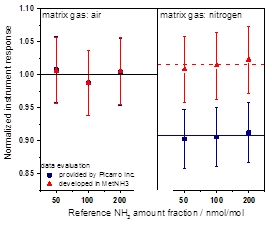 |
PTB’s optical transfer standard (OTS), a metrologically characterised Picarro CRDS analyser with a customised data evaluation algorithm for absolute, calibration-free measurements, participated in three measurement campaigns:
- June 2016: Intercomparison applying a test facility at UBA for investigating e.g. the cross-interference between NH3 and several atmospheric compounds (O3, SO2, and NO)
- August 2016: Intercomparison under field conditions in Scotland organised by REG CEH
- November 2016: Establishing traceability of the VTT sampling-free spectrometer via the calibration of another CRDS analyser at PTB.
In each case, the OTS was measuring against METAS’ permeation reference gas generator ReGaS1. Partners are currently processing the newly collected data which provides an excellent basis for the validation of PTB’s optical transfer standard and its new data evaluation algorithm.
Using ReGaS1 and the OTS during the November measurements, PTB and METAS further employed REG CEH’s humidity and aerosol generator PReHAGS to investigate the influence of such air constituents on reference gas measurements on which―to the best of our knowledge―few studies have been published so far, in spite of the high importance to the air quality measurement community. Furthermore, this offered an early opportunity to test the new humidity correction which Picarro Inc. released subsequently to the joint investigation of humidity cross-interference with Partner NPL (find link to publication in news section). Although not required by the OTS when applying the data evaluation customised by PTB, the correction was still available through the spectrometer’s pre-installed data evaluation.
Partner VTT finished the technical work on their sampling-free spectrometer and compared the instrument against a Picarro CRDS analyser which was calibrated using METAS’ reference gas generator ReGaS1 at PTB. This procedure allowed for the indirect comparison to PTB’s optical transfer standard. The operation of the sampling-free spectrometer was characterised e.g. with respect to its response time, linearity and sensitivity. Due to somewhat instable operation of the selected laser source the original goal for sensitivity could not be met, but thanks to its instant response and traceability of the ammonia amount fraction measurement results, this spectrometer works as a potential means for an instrument reference method for reliable online ammonia measurement.
WP3: Validation/Dissemination to Field Measurement Techniques
Progress until December 2016
The planned NH3 low cost sensor validation programme required in WP3 has begun using NPL’s Controlled Atmosphere Test Facility (CATFAC), following the completion of characterisation tests aimed at demonstrating the performance of the facility (See Figure 3). Ammonia Primary Standard Gas Mixtures (PSMs), developed at NPL, for WP1 were diluted dynamically to provide calibration mixtures of dry and humidified ammonia atmospheres of known composition in the nmol mol−1 range, under well characterised conditions of temperature and relative humidity. The rapid measurement of the online amount fraction of ammonia in the CATFAC involved sampling with a commercial optical laser sensor, based on cavity ring-down spectroscopy (CRDS), which was manufactured by Picarro Inc.
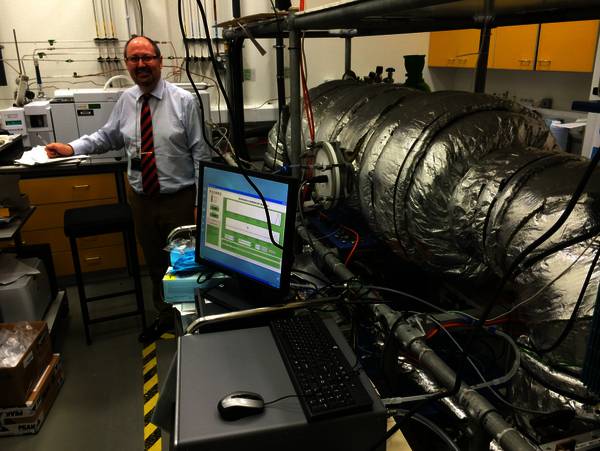 |
A correction to the on-line NH3 measurements was found to be required to reduce the undesirable effects of cross interference by water vapour, and this was implemented in collaboration with the CRDS instrument manufacturer. The problem consisted of a direct cross interference from nearby spectroscopic features of H2O and also an indirect cross interference from this molecule due to collisional broadening, which alters the line-shape of the ammonia spectrum. This effect is highlighted in Figure 4 for spectra of ammonia (3 µmol mol-1) in air with varying water vapour: 1 mmol mol-1 (black), 10 mmol mol-1 (green) and 25 mmol mol-1 (blue).
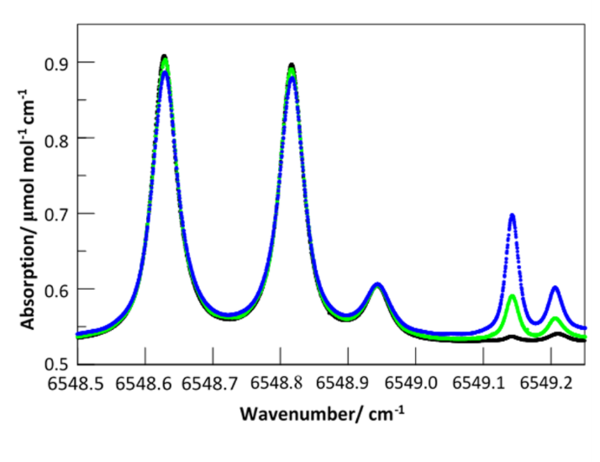 |
The development of stable PSMs at known amount fractions and water vapour enabled NPL to supply the manufacturer with validated traceable test data results to improve the spectral fitting routine of the CRDS.
Table 1 summarises the results obtained from a series of NH3 lack of fit plots where the known delivered NH3 input concentrations were compared against the corresponding NH3 CRDS measurements. The tests were carried out in the relative humidity range of 0-70%, and the near simultaneous measurements of water vapour made by the CRDS were employed in the correction mechanism.
Within the experimental uncertainty, the results for the original NH3 raw data and the corrected spectral fitting data agree for the dry atmospheres, but as the relative humidity increases the original spectral fitting routine begins to under read. In the improved fitting routine this problem has been overcome. A Publication by N. A. Martin et al. on "The applicability of a cavity ring-down spectrometer to measurements of ambient ammonia using traceable primary standard gas mixtures" has been published in Applied Physics B Lasers and Optics.
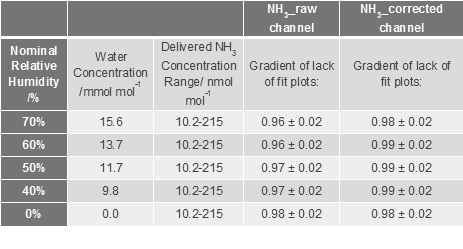 |
As part of the planned NH3 sensor validation programme in WP3, NPL’s Controlled Atmosphere Test Facility (CATFAC) was employed for six 28-day exposure tests with ALPHA, Gradko, PASSAM and Radiello diffusive samplers (14 days), and DELTA denuders. The exposed samplers have been returned to the different manufacturers for analysis. Fig. 5 shows the percentage deviation reported by each participant from the known traceable concentrations of NH3. The results are currently being employed to determine new values of the diffusive sampling rates for the devices tested.
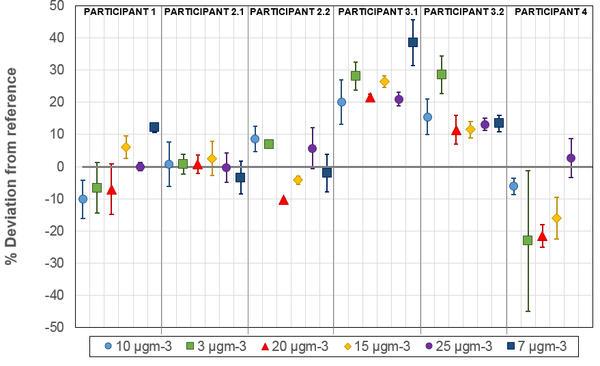 |
The instrument intercomparison at CEH Edinburhg, Scotland deployed 16 instruments and samplers over the period 15th August – 16th September 2016 at intensively managed grassland (Easter Bush site). Technologies included (cavity-enhanced) absorption spectrometry, photoacoustic spectroscopy, differential optical absorption spectroscopy (DOAS) and wet chemistry methods at a measurement height of 1.7 m. During the campaign both ambient and elevated NH3 conditions were experienced with concentrations ranging between <1-300 ppb. Portable calibration systems developed by METAS and NPL were deployed and field tested during the intercomparison. Challenges with inlet-design, ambient conditions and practical logistics were coped with and most instruments were compared against the calibration systems at the beginning and end of the experiment.
At the passive sampler intercomparison at the Whim Bog field site, two 4-week exposure periods were undertaken. Eight sets of samplers were deployed at four positions at the site on custom made sample posts. It is thought that this is the first field experiment of its kind integrating a metrology experiment with an ecosystem manipulation site. Initial results showed that the concentration range the passive samplers were exposed to was between 1ppb up to 100 ppb.
Both studies are the most recent and largest to date investigating the applicability of both commercial and research instrumentation for the measurement of ambient NH3. It is planned from the results of this study to draw conclusions regarding recommendations for measurement of ambient NH3 by active and passive sampling methods. This will enable further understanding of ambient NH3 and the impacts of mitigation strategies. Initial results from both intercomparisons have been presented in December 2016 and peer-review papers are anticipated being written in early 2017.
WP4: Creating Impact
The second MetNH3 workshop on ammonia measurement methodology with participation of all project partners as well as collaborators and stakeholders will be held at METAS, Bern Switzerland 09-10 May 2017. For more information see news section.
Article on MetNH3 published in the conference catalogue of CIM2015 (Congrès International de Métrologie).
MetNH3 consortium publication under the lead of A. Pogány titled "A metrological approach to improve accuracy and reliability of ammonia measurements in ambient air" in Measurement Science and Technology.
Publication by N. A. Martin et al. on "The applicability of a cavity ring-down spectrometer to measurements of ambient ammonia using traceable primary standard gas mixtures" in Applied Physics B Lasers and Optics. This work has been carried out in the framework of MetNH3.
MetNH3 Newsletter 1 (Feb 2015)
MetNH3 Newsletter 2 (Oct 2015)
MetNH3 Newsletter 3 (Dec 2016)
MetNH3 Newsletter 4 (June 2017)
Article on MetNH3 published in METinfo 2/14, METAS' journal of metrology
For more impact activities, please visit the "News" section
